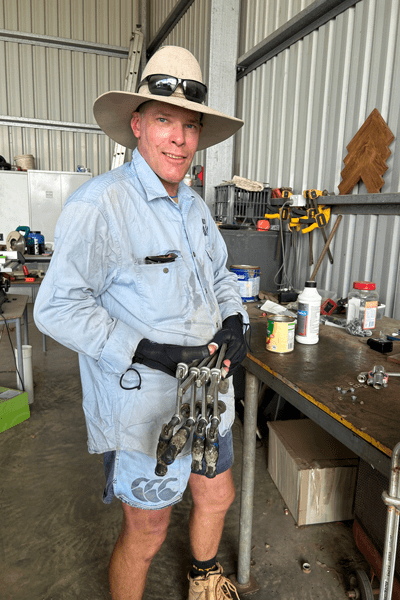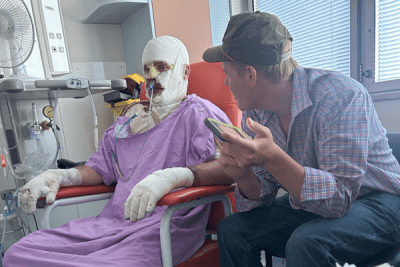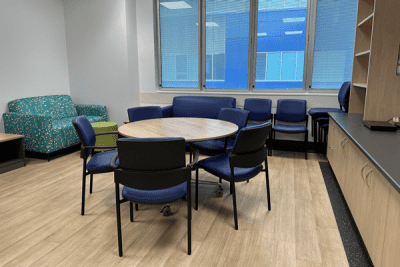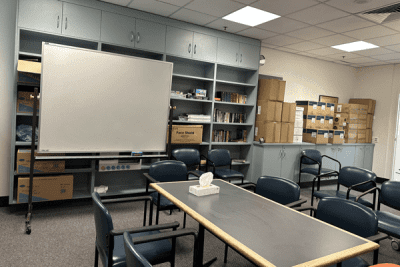Research shows patients with burn injuries recover better if they are active. Here’s how RBWH’s burns unit is getting them moving.

Burns patient Frank said getting out of bed made a huge difference to how he felt.
Frank Van Bael was at work pouring petrol into the carburettor of an old car when the motor backfired and blew burning petrol all over him.
His long-sleeved, buttoned work shirt caught fire and he was unable to get it off. He suffered burns to his face, chest, upper arms and hands. He doesn’t remember anything from the first five days after the accident as he was in an induced coma.
Frank, who lives in Theodore, west of Bundaberg, was initially taken to his local hospital before being flown to RBWH, where he would spend the next five weeks as an inpatient at the Professor Stuart Pegg Adult Burn Unit, and another month attending outpatient physiotherapy and occupational therapy sessions before returning home.
Frank’s wife Vanessa said staff in the burn unit were compassionate right from the start, in what was an uncertain time.
“I was extremely grateful for a phone call soon after midnight to say Frank had arrived and they gave me an update. I spoke to both the ICU doctor and burns doctor and I felt so reassured that Frank was in safe hands after that call,” she said.
“I know how busy everyone is but taking that time to talk to me meant so much.”
Aside from providing critical care to their patients, the burn unit at RBWH also ensures patients move about and exercise as much as possible, with research showing early mobility aids in recovery.
After a burn injury, the skin will tighten to try to heal the wounds as quickly as possible, explained Dr Jason Brown, Director of the burn unit. If left without treatment patients can develop skin contracture or limitation to their skin, muscles and joints.
Exercise programs, started as early as possible after burn injury, therefore, have numerous benefits for patients, including improved lung capacity, skin flexibility and movement, muscle strength and better mental health.
Anita Plaza, who is the Consultant Physiotherapist in the burn unit, regularly works with patients with burn injuries who describe this process of skin contracture during healing.
“Patients tend to describe the feeling of skin tightness as being inflexible, stiff, restricted and like a suit of armour limiting them from moving to their normal ability,” Anita said.

Frank suffered burns while working on an old car.
“You cannot do any further damage to the skin by performing exercises as guided by your physiotherapist early after burn injury.”
But it’s often challenging to get the patients up and moving, which was the catalyst for the research.
“The aim of our recent research project, supported by the Royal Brisbane and Women’s Hospital Foundation, was to investigate enablers and barriers to participation in physical activity programs from the perspective of both the patients and the clinicians in the burn unit,” Anita said.
The major barriers preventing patients participating in exercise programs were pain levels, fear of moving or not fully understanding the skin contracture process during healing. The burn unit is attempting to counter these with a new research project looking at novel pain management strategies and improved resources for patients including a new look physiotherapy website for patients to improve understanding.
Some exercise enablers were also identified:
- supportive staff
- peer support
- environmental factors such as access to outdoor spaces
- a more engaging environment in the burn unit.

The new burn unit lounge is one way to encourage patients to get up and move around
A new patient lounge in the burn unit, funded with support from Burnslife and the RBWH Foundation, is the most obvious sign of the improvements made as a result of the study. It’s a far more comfortable space for patients than was previously available, containing a new kitchen, couches and a giant TV screen.
Changes to staff routines also provide a wider window of support to patients. Physiotherapy assistant support is now used to assist patients to mobilise at breakfast times, as mornings were identified as a particularly difficult time of the day by both patients and staff.
The RBWH Foundation has also funded the Survivors Offering Assistance in Recovery (SOAR) program, wherein past patients volunteer their time to support others with burn injuries.
Physiotherapy-led walking groups also take place, improving physical activity levels and mental health.
For patients like Frank, anything to get them on the road to recovery sooner is a huge plus. In his case, he was keen to move around as soon as possible.
“Just getting out of bed made such a difference to how I felt,” Frank said.

Before the upgrade the space was less appealing for patients.
“All the staff were wonderful to help keep me moving and helping me in general. They got me a wheelchair and I used to spend an hour outside each afternoon with my family to get some fresh air, this was a highlight of my days.
“It was not easy for me being cooped up in a hospital room or even being in the city. It was so good to get home again.”
Vanessa said the new lounge would make a massive difference to patients staying for long periods.
“I think it would be great as you could meet and strike up valuable conversations with other burn patient’s families, in times like that any support you can get is so valuable. They are long days and having a place to take a break is so beneficial.”
Vanessa said the staff in the burn unit made a tough experience so much easier to manage.
“The staff go above and beyond and the teamwork was brilliant. I always felt included and was kept up to date with treatments,” she said.
“Our three sons and I were always welcome, and it made an extremely difficult time just that little bit easier.
“I will never forget the care Frank received. A credit to all—every staff member on the unit cared.”
